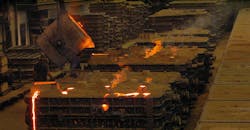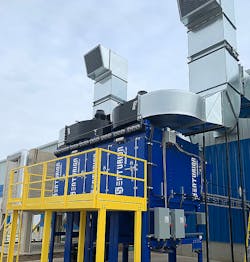Metalcasting processes – from molding to melting, shakeout, grinding, and finishing – create emissions that are hazardous for workers and the environment. What follows here is a review of the health hazards and exposure limits for dust in metalcasting operations, and an evaluation of various dust-control strategies that can help foundries to ensure compliance with OSHA and EPA regulations.
Air Quality and Worker Health & Safety
Foundries processes result in several different types of dust and emissions, each with its own health concerns and exposure limits. These include: airborne silica, metallic dusts, and volatile organic compounds (VOCs.)
Respirable crystalline silica. Most of the dust that accumulates in foundry operations is a byproduct of metalcasting processes. Sand casting processes, of course, generate airborne silica dust. Respirable crystalline silica (RCS) — defined as particles of crystalline silica with a size of less than 4 microns (µ) — is dust that may be inhaled deeply into the lungs, where it can be the cause of considerable damage to workers’ health, including:
• Silicosis, a serious lung disease that can be fatal if left untreated;
• Lung cancer; and
• Kidney disease.
Metallic dust. Foundry workers also may be exposed to metallic dust and fumes produced during melting, pouring, or finishing processes.
• Molten metal releases dangerous gases or fumes that contain tiny molecules of the metals, additives, and contaminants present in the alloy. These molecules may be breathed deeply into the lungs, where they can also cross into the bloodstream and spread to other organs.
• Finishing processes such as abrasive blasting, shot peening, wheel blasting, grinding, or polishing create coarser metallic dust, which may be mixed with silica.
Many of the emissions produced in foundry operations have been designated as toxic air contaminants, including arsenic, cadmium, nickel, lead, and hexavalent chromium. Fume composition depends on the types of metals and alloys being used. Risks associated with breathing metal dusts include:
• Metal fume fever, an acute flu-like illness;
• Chronic lung diseases, including pulmonary fibrosis, chronic bronchitis, and chronic obstructive pulmonary disease;
• Manganism, a neurological disorder with symptoms similar to Parkinson’s Disease;
• Kidney damage; and
• Stomach ulcers
VOCs and other metalcasting emissions. Metalcasting releases organic emissions and noxious gases in addition to metal fumes. These emissions come from the burning of coke as fuel and from additives and contaminants in the molten metal or in the casting sand.
• Burning coke (or oil) as fuel releases carbon dioxide, carbon monoxide, sulfur dioxide, nitrogen oxides, and organic particulate matter.
• Green sand molds contain a variety of binders or other chemicals used to improve the surface finish and reduce defects in castings. Common organic emissions from sand molds include acetophenone, benzene, cumene, dibenzofurans, dioxins, formaldehyde, methanol, naphthalene, phenol, pyrene, toluene, triethylamine, and xylene.
Most organic emissions result from burning or vaporization of organic resins used in moldmaking. During pouring, cooling, and casting shakeout, resins may be incinerated by the heat of the process, sublimated into the air, or adsorbed back into the mold. There is evidence that exposure to these substances can cause health problems, including cancer and disorders of the respiratory, reproductive, and central nervous systems.
Meeting Exposure Limits for Dust and Fumes
The U.S. Occupational Safety and Health Administration (OSHA) sets permissible exposure limits (PELs) for various substances that are commonly found in foundry emissions, such as total particulate matter, respirable crystalline silica, metal fumes, and gases such as carbon monoxide and sulfur dioxide. These PELs set limits on the amount of each substance that workers may be exposed to over a given time period. OSHA PELs have the force of law; employers that do not meet the PEL may face significant fines or legal action.
OSHA has set a PEL for total particulate of 15 mg/m3 as an eight-hour, time-weighted average, with a PEL of 5 mg/m3 as the respirable fraction.
For some highly toxic substances — including RCS, lead, cadmium, and hexavalent chromium — OSHA also sets a separate action level (AL), which usually is half the PEL. For substances with an AL, employers are required to have a written control plan in place if emissions are above the action level. They also may be required to take other actions, such as medical surveillance and worker education.
Foundry operators also should be aware of recommended exposure limits set by the National Institute for Occupational Safety and Health (NIOSH) and the American Council of Governmental Industrial Hygienists (ACGIH). These organizations set guidelines based on the best scientific evidence, which often are lower than the PEL set by OSHA. While these recommendations do not have the force of law, employers may want to aim for more stringent exposure limits to create a better working environment and to minimize health concerns.
Creating a Dust-Control Plan
Foundries must have a dust-control plan in place to protect workers from hazardous fumes and emissions.
Air-quality testing and monitoring. To ensure that the operation is meeting PELs, foundries should implement an air-quality testing and monitoring program. Testing is used to establish a baseline when making mitigation decisions, for validation once systems have been put in place, and for periodic or continuous monitoring to ensure that air quality remains within expected parameters. This may involve one or both of the following:
• Air quality meters or sensors to measure the levels of particulate and gaseous emissions (e.g., VOCs, sulfur dioxide) at various locations in the facility.
• Wearable exposure monitors to determine exposure levels for individuals as they go about their normal shift activities.
Some types of sensors will provide continuous readings of metrics such as total particulate concentration and the presence of carbon monoxide. But to get a complete understanding of the composition of emissions, samples will have to be sent to a laboratory for analysis. Laboratory testing may be needed to determine whether PELs are being met for specific substances, such as hexavalent chromium or lead.
Dust hazard elimination/reduction. Where possible, foundries should seek to eliminate sources of hazardous dust and emissions or reduce the volume of dust and fumes produced. Examples include:
• Substituting more hazardous materials with less hazardous materials (e.g., switching to a non-silica-based mold material to eliminate respirable crystalline silica.)
• Changing processes to reduce how much dust or fume ends up in the air (e.g., using water spray systems to keep dust from becoming airborne.)
Engineering controls. Engineering controls are a core element of the dust-control plan. Engineering controls are measures that are designed to reduce or eliminate exposure to hazards in the workplace by modifying the environment or the equipment used. Examples of engineering controls for dust and fumes include:
• Using exhaust ventilation fans or ambient air-filtration systems to pull rising fumes from hot processes out of the building. Exhaust ventilation is typically accompanied by the use of makeup air systems to bring in fresh air and dilute contaminants to acceptable levels, to meet the PEL.
• Keeping dust- and fume-creating processes under hoods or enclosures with the use of a source-capture dust-collection system. A dust collector (such as a cartridge-style dust collector or baghouse) is used to filter contaminants out of the air.
• Operating vacuum systems for housekeeping activities, instead of sweeping with brooms or blowing down equipment with compressed air.
The EPA National Emissions Standards for Hazardous Air Pollutants (NESHAP) program sets limits on emissions for foundries, including particulates and hazardous pollutants such as benzene, formaldehyde, and hexavalent chromium. Engineering controls must be designed to meet both OSHA requirements for indoor air quality and EPA requirements for environmental emissions.
PPEs and Dust Collection
If PELs cannot be met with engineering controls alone, personal protective equipment (PPE) such as powered air-purifying respirators (PAPR) may be required for employees working in areas with high exposures. Note that engineering controls must be used as the primary remedy; PPE should only be used when PELs cannot be met in other ways.
Combustible dust mitigation. While silica dust is inert, metal dust and fumes created in foundries may be combustible. Collection systems for combustible dust must meet National Fire Prevention Association (NFPA) guidelines for systems design (e.g., the use of an NFPA-compliant deflagration system). NFPA 652 (Standard on the Fundamentals of Combustible Dust) is a good starting point for compliance.Foundries have specialized requirements when it comes to dust collection, such as:
• High airflow (CFM) requirements;
• Collection of abrasive material (e.g., sand from casting processes);
• Collection of noxious gases and fumes along with dry particulate;
• Strict PELs for many of the fume types generated; and,
• The presence of combustible dust.
For these reasons, it is important to work with a qualified engineering firm when designing a dust-control strategy. The right engineering partner will work with you to develop a testing and monitoring strategy and design dust collection and ventilation systems for OSHA and EPA compliance.
Mike Meyer leads the Clean Air Academy for RoboVent and is an instructor for the Michigan Industrial Ventilation Conference.
About the Author
Mike Meyer
Exec. Vice President, Solutions Sales
Mike Meyer leads the Clean Air Academy for RoboVent and is an instructor for the Michigan Industrial Ventilation Conference. He is a recognized industry expert with 40+ years of experience in industrial ventilation and environmental services.


